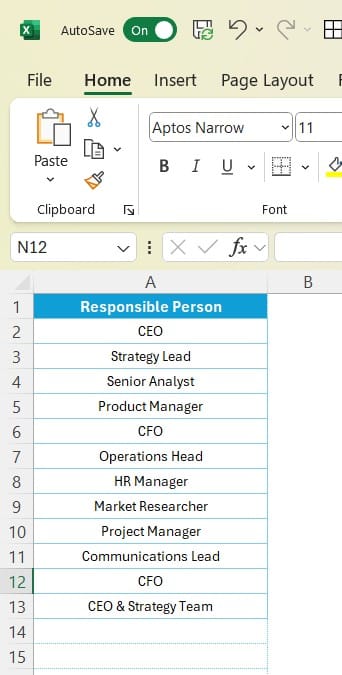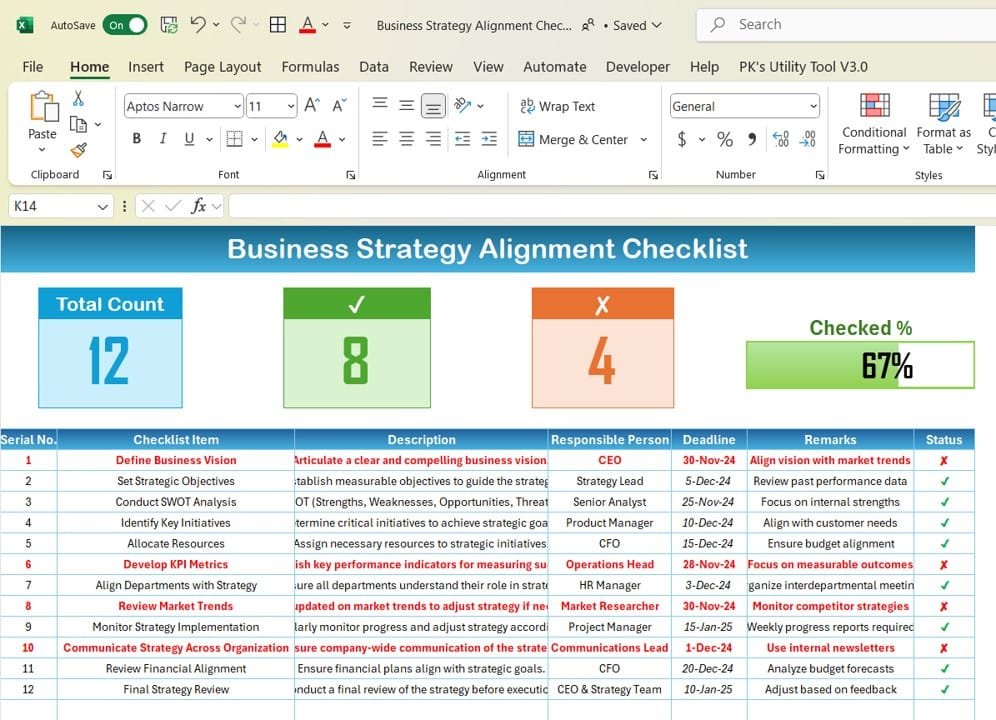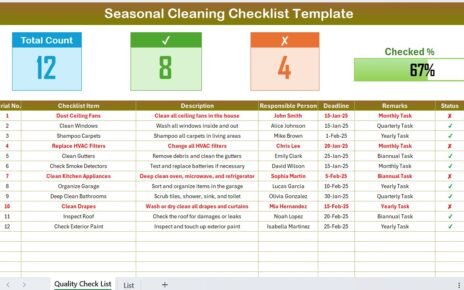In today’s fast-paced business environment, aligning your business strategy with your company’s goals and operational capabilities is essential for sustained success. A Business Strategy Alignment Checklist serves as a powerful tool to ensure that every department and team within the organization is moving in the same direction. This article will provide a comprehensive overview of how to use a Business Strategy Alignment Checklist, its key features, advantages, and best practices. We will also discuss opportunities for improvement and answer frequently asked questions (FAQs).
Click to buy Business Strategy Alignment
What Is a Business Strategy Alignment Checklist?
A Business Strategy Alignment Checklist is a tool that helps businesses ensure their strategic objectives are effectively aligned with their day-to-day operations. It is designed to ensure that all parts of the organization are working cohesively toward common goals, with clear responsibilities, deadlines, and measurable outcomes.
This checklist typically includes a series of tasks, each with assigned responsibilities, deadlines, and progress tracking. The goal is to ensure that each strategic action is executed properly and in alignment with broader business goals.
Key Features of the Business Strategy Alignment Checklist
A typical Business Strategy Alignment Checklist consists of the following components:
Worksheets:
The template includes two main worksheets:
- Business Strategy Alignment Checklist: This is the core sheet for capturing all the checklist information.
- List Sheet: This worksheet helps in organizing responsible persons and creating dropdown options for the main checklist.

Click to buy Business Strategy Alignment
Top Section:
Includes three cards that display information about the checklist’s progress:
- Total Count: The total number of items in the checklist.
- Checked Count: The number of completed items.
- Crossed Count: The number of items that have been marked as not applicable or unachievable.
- Progress Bar: Displays the percentage of completed tasks.
Checklist Table:
The main table lists various checklist items, their descriptions, responsible persons, deadlines, remarks, and status.
Each item in the checklist can be marked as completed (✔) or not completed (✘), helping teams stay on track.
How Does the Business Strategy Alignment Checklist Work?
The checklist is designed to guide businesses through a structured process. The main table includes the following columns:
- Serial No.: A unique identifier for each task.
- Checklist Item: The specific task or action to be completed.
- Description: A short explanation of the task.
- Responsible Person: The individual or team responsible for completing the task.
- Deadline: The due date for completing the task.
- Remarks: Any important notes or instructions related to the task.
- Status: The current progress of the task, marked as either ✔ (completed) or ✘ (not completed).

Click to buy Business Strategy Alignment
Advantages of Using a Business Strategy Alignment Checklist
- Improved Focus and Clarity: A well-structured checklist helps align everyone in the organization around common goals. Employees know exactly what needs to be done, by whom, and by when.
- Better Accountability: With specific tasks assigned to individuals, a Business Strategy Alignment Checklist fosters accountability. It becomes clear who is responsible for each step in the strategic execution process.
- Enhanced Communication: The checklist acts as a centralized reference, improving communication within teams and across departments. Regular updates and reviews ensure that everyone stays informed about progress.
- Better Resource Allocation: By clearly outlining the strategic tasks, companies can allocate resources (time, money, manpower) more efficiently, ensuring that critical initiatives receive the attention they need.
- Tracking and Progress Monitoring: The checklist allows for real-time monitoring of strategy execution. Teams can quickly identify areas that are falling behind or tasks that need additional resources or focus.
- Increased Transparency: Having a shared checklist makes strategy execution more transparent, allowing leadership to view the progress of key initiatives and take corrective actions when necessary.
Opportunities for Improvement in Business Strategy Alignment
While a Business Strategy Alignment Checklist is an excellent tool, there are always opportunities for improvement. Below are some areas where businesses can fine-tune their approach to strategy alignment:
- Incorporating Agile Methodologies: Traditional business strategy planning can sometimes be rigid. Adopting agile practices, such as regular feedback loops and iterative updates, can improve flexibility and responsiveness to market changes.
- Increased Collaboration Across Departments: Strategy alignment isn’t just about checking tasks off a list. Encourage cross-functional teams to collaborate and contribute insights to ensure that all strategic actions are well-rounded and supported.
- Use of Automation Tools: Integrating tools that can automate status tracking and progress reports can make the checklist more efficient. Project management platforms can help provide real-time updates and reduce manual tracking errors.
- Regular Review and Update: The business landscape is always evolving. Strategy alignment checklists should be reviewed and updated periodically to ensure that they remain relevant and that new opportunities or challenges are addressed.
- Emphasis on Long-Term Goals: While it’s important to meet short-term objectives, businesses should also ensure that their strategy alignment is focused on long-term goals. This can be achieved by regularly revisiting the overall mission and vision of the company.
Best Practices for Using the Business Strategy Alignment Checklist
To maximize the effectiveness of your Business Strategy Alignment Checklist, consider the following best practices:
- Ensure Clear Goal Setting: Before using the checklist, ensure that the business’s vision and strategic objectives are well-defined. This will guide the creation of relevant checklist items.
- Involve Key Stakeholders: Involve leadership and department heads when developing the checklist. This ensures that all relevant perspectives are considered and that the checklist addresses the real needs of the organization.
- Set Realistic Deadlines: Be realistic when assigning deadlines. Ensure that each task can be completed within the specified time frame, allowing room for unforeseen delays or challenges.
- Use the Checklist as a Living Document: Don’t let the checklist become static. Review it regularly to ensure that tasks are completed on time, and update it as necessary to reflect changing priorities or market conditions.
- Leverage Technology: Use project management or checklist software to automate the process, track progress, and generate reports. This can save time and reduce the chances of human error.
- Foster Accountability: Assign clear responsibility for each task, and ensure that individuals are held accountable for meeting deadlines and achieving results.
Frequently Asked Questions (FAQs)
- What is the purpose of a Business Strategy Alignment Checklist?
The purpose of a Business Strategy Alignment Checklist is to ensure that a company’s strategic goals are aligned with its operational activities. It provides a clear roadmap for achieving strategic objectives and helps monitor progress throughout the process.
- How do I use the checklist effectively?
To use the checklist effectively, start by defining your business’s vision and strategic objectives. Then, break down these objectives into smaller tasks, assign responsibilities, set deadlines, and track progress. Regularly update the checklist and adjust as needed to stay aligned with your goals.
- Can I use the checklist for all types of businesses?
Yes, the Business Strategy Alignment Checklist is versatile and can be adapted for businesses of all sizes and industries. It is most effective when customized to meet the specific needs and goals of your organization.
- How do I ensure accountability with the checklist?
Assign a responsible person for each task in the checklist, and set clear deadlines. Regularly review progress and follow up to ensure tasks are completed on time. This fosters accountability within the team.
- What should I do if the checklist is not being followed?
If the checklist is not being followed, identify the root cause. Are deadlines unrealistic? Are tasks unclear? Work with the team to address challenges, adjust the checklist if necessary, and reinforce the importance of strategic alignment.
Conclusion
A Business Strategy Alignment Checklist is an invaluable tool for organizations aiming to achieve their strategic goals with clarity and precision. By ensuring that all departments and teams are aligned with the broader business vision, companies can improve efficiency, foster accountability, and monitor progress toward achieving their objectives.
Visit our YouTube channel to learn step-by-step video tutorials



